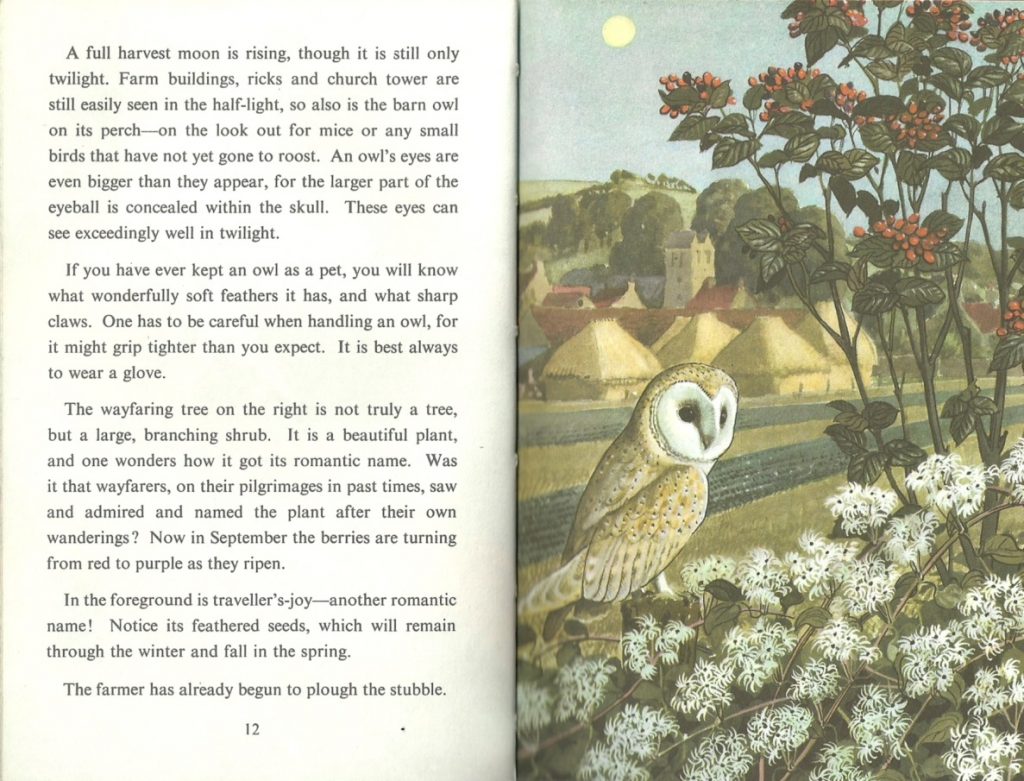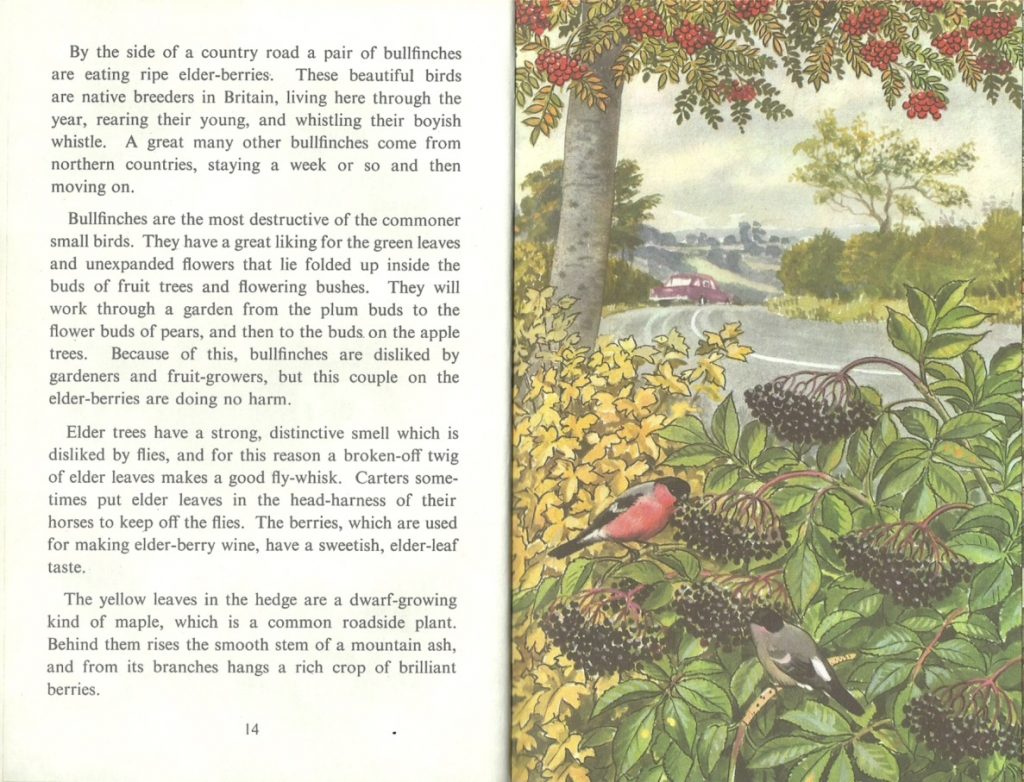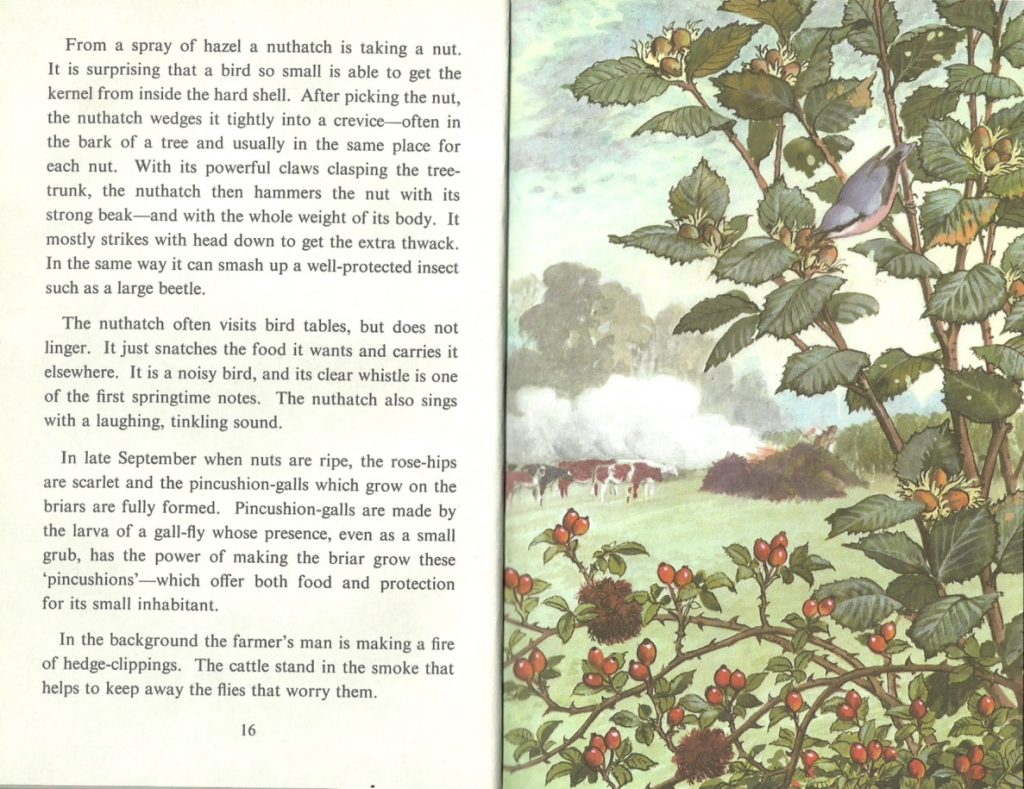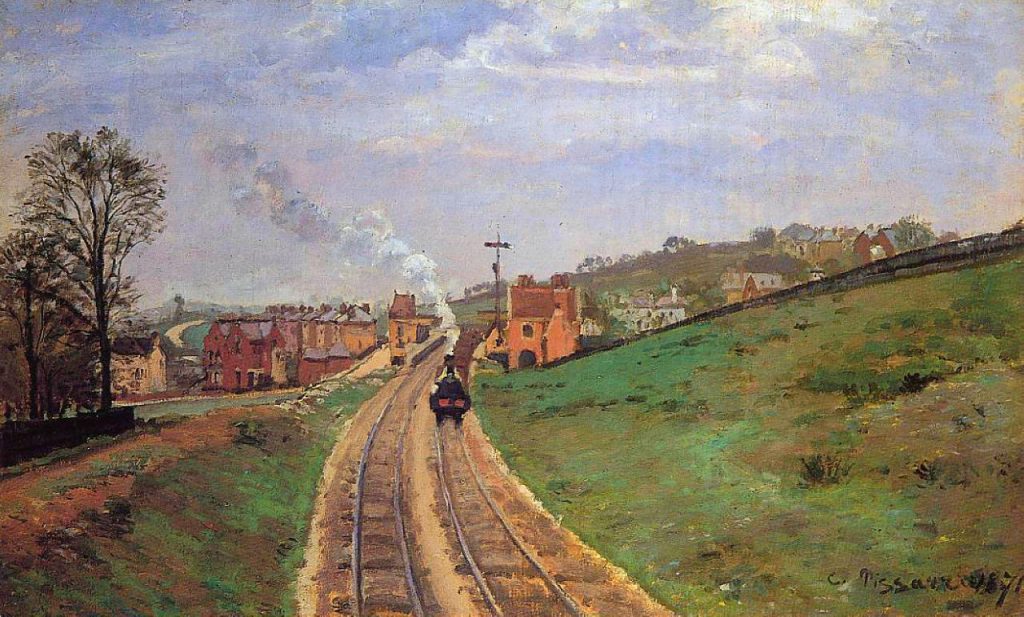A celebration of autumn: part 2 – fruit
You can see my first post on autumn here. In this post, I have added more spreads from the delightful Ladybird book ‘What to look for in Autumn’, written by E. L. Grant Watson and with illustrations by C. F. Tunnicliffe (copyright acknowledged) as well as a few pictures I took at Sydenham Hill Wood. This post talks a bit more about autumn fruit. These posts have another purpose (if there has to be one). We are exploring both actual and perceptual changes in the British countryside over a fifty-year period. The work already has its own narrative.
The hayrick

Hayricks might be a thing of the past but luckily but there is still plenty of Traveller’s Joy, also known as Old Man’s Beard or the rather more prosaic Clematis vitalba. It’s a great food source for many moth species but its invasive habit makes it a problem outside the UK, particularly in New Zealand. In France it has the name herbe aux gueux, meaning beggar’s herb, because (according to this article) beggars used the juice of the plant to deliberately inflict ulcers, so arousing the pity of passers-by.
The wayfarer
The Wayfarer tree (known in the past as hoarwithy, an entirely pleasing name) is also relatively common but often goes unremarked. E.L. Grant Watson wonders how it got its romantic name of Wayfarer tree, speculating that it was so called by passing pilgrims. There is a poem, reproduced below, that suggests a similar origin:
Wayfaring Tree
W.H.
What ancient claim
Hast thou to that right pleasant name?
Was it that some faint pilgrim came
Unhopedly to thee,
In the brown desert’s weary way,
Midst thirst and toil’s consuming sway,
And there, as `neath thy shade he lay,
Blessed the Wayfaring Tree?
Dictionary of Phrase and Fable, E. Cobham Brewer, 1894
A nice idea, but this description applies to the Guelder Rose, Viburnum opulus, not the Wayfarer tree, which is Viburnum lantana: besides, the fruit is toxic to humans. One uncredited source suggests that the name was invented by the Elizabethan botanist John Gerard. Confusingly, the name ‘Wayfarer tree’ is also applied to the European rowan (Sorbus aucuparia). The idea that the shrub is a natural signpost has some credibility, and so perhaps the name ‘Wayfarer’ was applied to any shrub or tree with vivid red berries.
Extraordinary that Grant Watson seems to consider that any reader might have had a pet barn owl. At the time the book was written DDT would have been in use in the UK, one of the causes of significant population decline in barn owls.
Wild berries

And here is one of the other ‘Wayfarer’ trees, the Rowan or Mountain Ash (Sorbus aucuparia), a tree with a history of usage going back to prehistoric times. I’m thinking of making some Rowan jelly if I can find some fruit, it’s been a long time since I tasted any (here’s a good recipe).
At the time of writing, it is too late for elderberries (Sambuca nigra). Like much wild fruit, elderberries are slightly toxic until cooked, but you can make wonderful things from them without too much effort. Cordial, wine and syrup can be made from the flowers and the berries, but the leaves, and all the other parts of the plant, contain cyanogenic glycosides – hence the use against flies.
Bullfinches (Pyrrhula pyrrhula) were until recently very common but suffered a dramatic decline in numbers. Happily numbers are rising again. If you can’t see bullfinches, you might be able to hear them: their particularly mournful call can be easily identified.
The Hazel coppice

This illustration is a personal favourite (I love the rust on the hazel leaves). Hazel (Corylus avellana) was once very widespread, and much used in hedgerows and coppicing. It supports over thirty moth species and it follows that the reduction of hazel coppice has had a negative effect on biodiversity. Moreover, the eradication of temperate rainforest through the intensive hill farming of sheep has had an untold consequence. This detailed look at Atlantic hazel in Scotland reveals the beauty and mystery of a particular type of hazel forest and the extraordinary life that it supports.
The jewelled rose-hips of the dog-rose (Rosa canina) are a particularly wonderful sight in Autumn. I often feel like picking one of these juicy gems and eating it, but unfortunately, the seeds are covered with irritant hairs (used once for itching powder) and need to be removed carefully before consumption. If you can persevere with the de-seeding task, you’ll be rewarded with fruit high in antioxidants and vitamin C. They also taste good – and can be made into tea, wine and syrup. I almost used to look forward to having a cold as a child because it meant a dose of rose-hip syrup! It’s good that Tunnicliffe painted Robin’s Pin-cushion galls, a chemical response caused by the gall wasp (Diplolepis rosae). Birds and other insects predate the galls. What intricate relationships exist around the hazel and dog-rose alone!
The Nuthatch (Sitta europaea) is also common, with an increasing population. If you see a bird running headfirst down a tree trunk, you are not seeing things, it’s a nuthatch. Here’s a link to its call.
Sydenham Hill Wood

I visited Sydenham Hill Wood quite frequently once – it is an interesting mixture of old and newer woodland. A railway used to run through it and there was a station, Lordship Lane. The line was closed in 1954 (so the infamous Baron Beeching was not responsible) but the closure meant that new woodland could emerge alongside the old. Astonishingly, the impressionist painter Camille Pissarro painted a scene of the track.
This is an old photo of the footbridge itself:

And a contemporary view from the footbridge looking down the old track:

You can walk across the footbridge Pissarro used and compare the painting to the current view of trees – this must be one of the few reversals from open land to woodland in London. It is managed by the London Wildlife Trust and it’s a wonderful place for many important and rare species, as well as a good spot for a short walk amongst glorious trees. Right now the forest floor is rich with fallen leaves and fungi. There’s a blog here about Sydenham Hill Wood with a wealth of information about its history and wildlife, but sadly not updated for a couple of years.
Hairy Curtain Crust
The wood has many species of fungi, including these fantastic bracket fungi (rejoicing in the name of Hairy curtain crust, identification courtesy of @wildlondon_SHW) growing from an old tree:


So far we have looked at the red berries of the Wayfarer tree, Rowan and Rose. To conclude this post here are another fruit, Holly berries dripping with rain, looking as pristine as one could hope.

